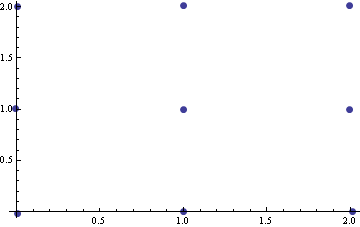Imagine I have $N \approx 10^5$ clouds of points in an array of the form:
UPDATED
numClouds = 10^3;
cloudList = Table[Table[{RandomInteger[{0, 2}] + RandomReal[{-0.1, 0.1}], RandomInteger[{0, 2}] + RandomReal[{-0.1, 0.1}]}, {j, 1, RandomInteger[{0, 50}]}], {i, 1, numClouds}];
Notice that we generate points here by first randomly snapping them to a coordinate in an integer lattice, and then adding some real number valued noise:
ListPlot[Flatten[cloudList,1]]
I'd like to move a sliding window over cloudList of size $k$ (e.g. $k = 10$) where we take all of the points in {cloudList[[i]], cloudList[[i+1]], ..., cloudList[[i+k]]}, establish cliques for points within a Euclidean distance $d$ of one-another (i.e. if we can place a circle of diameter $d$ over a set of points, it's a clique), and then replace all of the points within each clique with the median or mean point value of the given clique. I would like to do this without disturbing the array structure of cloudList.
In terms of finding a fast way to grab all the points within a critical radius of $\frac{d}{2}$, we can use a poorly documented version of Nearest:
Nearest[data, x, {n, r}]
give up to thennearest elements toxwithin a radiusr
The above was from an answer by the user "ssch" (https://mathematica.stackexchange.com/users/1517/ssch) to my question: Selecting for 2D points that are within a threshold distance of an upper- and lower-bound number of points
Update - I neglected to specify what should occur when points can belong to more than one clique. The user belisarius (https://mathematica.stackexchange.com/users/193/belisarius), for example, asked about the cliques for a point set Tuples[{1, 0}, 2] where r = 3/2. Here, all four points belong to the same clique:
list = Tuples[{1, 0}, 2];
nf = Nearest[list];
nf[list[[1]], {Infinity, N[3/2]}]
out :: {{1, 1}, {1, 0}, {0, 1}, {0, 0}}
So we'd set each point in this clique to {1/2,1/2}.
However, if we set r = 1, we have Binomial[4, 3] = 4 seperate cliques with overlapping points:
{{1, 1}, {1, 0}, {0, 1}}
{{1, 0}, {1, 1}, {0, 0}}
{{0, 1}, {1, 1}, {0, 0}}
{{0, 0}, {1, 0}, {0, 1}}
To resolve this, I'd like to generate each clique as above, compute a mean for each clique, and where points fall in multiple cliques, to randomly assign these points the mean or median value selected with uniform probability from each clique. However, I'd be open to simpler solutions that are easier to implement.
(2nd) Update - I have changed the method of generating the random test set s.t. we now first snap a randomly generated test point to a bounded integer lattice coordinate, then add noise.
(3rd) Update - This is more of a note, but I would be fine employing a simple greedy algorithm to partition points into clusters, or using FindClusters with a EuclideanDistance distance function (this is slightly less comfortable since I'm not exactly sure what the underlying algorithm is).




r == Sqrt[3/2]please consider the pointsTuples[{1, 0}, 2]and tell us which ones are the "established cliques" that you want to replace by its mean point value.Thanks! $\endgroup$r=1/10... you have almost the same number of possible cliques than points! $\endgroup$